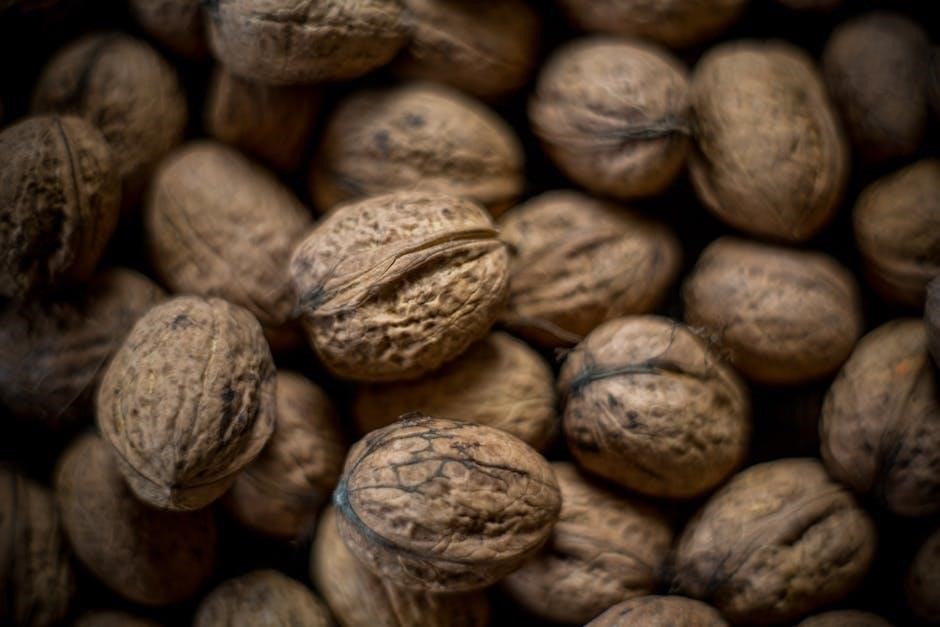
carnivore diet food list pdf
The carnivore diet is a restrictive eating plan that eliminates all plant-based foods, focusing solely on animal products like meat, fish, eggs, and dairy. This high-protein, zero-carb diet aims to optimize health by avoiding carbohydrates and processed foods, emphasizing whole animal-derived nutrients. The diet has gained attention for its simplicity and potential benefits, though it remains controversial among health experts. A carnivore diet food list PDF provides a comprehensive guide to approved foods, helping adherents navigate grocery shopping and meal planning effectively.
Overview of the Carnivore Diet
The carnivore diet is a high-protein, zero-carb eating plan that focuses exclusively on animal-derived foods. It eliminates all plant-based foods, including fruits, vegetables, grains, and legumes, emphasizing meat, fish, eggs, and small amounts of low-lactose dairy products. Proponents argue that this diet aligns with human evolutionary biology, promoting optimal health and weight management. Critics, however, raise concerns about its nutritional balance and long-term safety. The diet is often compared to a strict keto diet but without any plant-based components. Adherents typically consume a variety of meats, organ meats, and seafood, prioritizing fatty cuts for satiety and nutrient density. While controversial, the carnivore diet has gained popularity among those seeking a simplified, meat-only approach to nutrition.
Benefits and Potential Risks
The carnivore diet has sparked debate due to its potential benefits and risks. Advocates report improved weight loss, enhanced blood sugar control, and increased energy levels, while some experience better digestion and reduced inflammation. However, critics highlight risks such as nutrient deficiencies, particularly in fiber, vitamins, and minerals. The diet’s reliance on animal fats may also raise cholesterol levels and increase cardiovascular risk. Additionally, the complete exclusion of plant-based foods has drawn concerns from health experts, who argue that no single food group can provide all essential nutrients. While some find the diet beneficial, others caution against its long-term sustainability and potential negative health outcomes. It is crucial for individuals to consult healthcare professionals before adopting this restrictive eating plan.

Core Foods of the Carnivore Diet
The carnivore diet centers around animal-based foods, emphasizing high-quality meats, fish, eggs, and select dairy products. These foods provide essential proteins, fats, and nutrients, forming the diet’s foundation. The focus is on whole, unprocessed sources to maximize nutritional benefits and minimize health risks associated with processed items.

Meat Options
Meat forms the cornerstone of the carnivore diet, with a wide variety of options available. Beef is a popular choice, including cuts like ribeye, sirloin, and ground beef. Pork, lamb, and game meats such as bison and venison are also commonly consumed. Organ meats, like liver and kidney, are highly recommended for their rich nutrient profiles. Additionally, processed meats such as bacon and sausages can be included, though it’s advisable to opt for versions low in added sugars and preservatives; The focus is on sourcing high-quality, grass-fed, or wild meats to ensure optimal nutritional intake and minimize exposure to harmful additives. This diverse range of meats ensures that the diet remains satisfying and nutritionally robust.
Seafood Choices
Seafood is a key component of the carnivore diet, offering a rich source of protein and essential nutrients. Popular seafood options include fatty fish like salmon, tuna, and mackerel, which are high in omega-3 fatty acids. Leaner fish such as cod and tilapia are also great choices. Shellfish like shrimp, crab, and lobster provide variety and are packed with vitamins and minerals. Sardines and anchovies are smaller, nutrient-dense options that are easy to incorporate. When selecting seafood, it’s important to choose wild-caught or sustainably sourced varieties to minimize exposure to contaminants. Seafood adds diversity to the diet and supports overall health with its balanced fatty acid profile and high-quality protein content.
Poultry Selection

Poultry is a staple in the carnivore diet, offering lean and flavorful protein sources. Chicken, turkey, and duck are popular choices, with options like breasts, thighs, wings, and drumsticks. Organ meats from poultry, such as liver and giblets, are also encouraged for their nutrient density. Eggs, a versatile and high-protein food, are included in many carnivore diet plans; When selecting poultry, opt for pasture-raised or wild varieties to ensure higher quality and better nutrient profiles. Avoid processed or breaded poultry products, as they may contain unwanted additives. Poultry provides a diverse range of flavors and textures, making it a cornerstone of the carnivore diet alongside red meat and seafood. Incorporating a variety of poultry ensures a balanced and satisfying meal plan.
Eggs and Dairy Products
Eggs and low-lactose dairy products are integral to the carnivore diet, providing essential nutrients and variety. Eggs are a versatile and high-quality protein source, rich in vitamins and minerals. Dairy options like cheese, butter, and cream are allowed, especially those with minimal lactose content. These foods add healthy fats and calcium to the diet. When choosing dairy, opt for full-fat, grass-fed varieties to maximize nutritional benefits. Eggs can be consumed fried, boiled, or scrambled, offering flexibility in meal preparation. While some individuals may prefer to limit or avoid dairy due to personal tolerance, it remains a valuable component for many adherents of the carnivore diet.

Additional Foods and Considerations
Explore organ meats, fatty cuts, and low-lactose dairy for added nutrition. These options enhance variety and provide essential nutrients, ensuring a balanced approach to the carnivore diet.

Organ Meats
Organ meats are a cornerstone of the carnivore diet, offering dense nutritional value. Beef liver, heart, and kidneys are rich in vitamins like B12 and minerals such as iron. Chicken and duck organs, including liver and gizzards, provide additional diversity. These meats are packed with micronutrients essential for optimal health and energy. Incorporating them ensures a balanced intake of nutrients, supporting overall well-being on a meat-only diet. Organ meats also promote immune function and can enhance the diet’s effectiveness. They are versatile and can be prepared in various ways, making them a valuable addition to carnivore meals.
Fatty Cuts of Meat
Fatty cuts of meat are a staple in the carnivore diet, providing essential energy and satisfaction. Ribeye steak, ground beef, short ribs, brisket, and pork belly are popular choices due to their high fat content. These cuts are not only flavorful but also rich in nutrients like fat-soluble vitamins and conjugated linoleic acid (CLA). Fatty meats help maintain a ketogenic state and support overall health. They are versatile and can be cooked in various ways, from grilling to slow-cooking. Incorporating fatty cuts ensures a balanced intake of macronutrients and keeps meals satisfying. They are a key component of the carnivore diet, aligning with its focus on whole, unprocessed animal products.
Low-Lactose Dairy Products
Low-lactose dairy products are optional additions to the carnivore diet, offering versatility and nutrients. Hard cheeses like cheddar, parmesan, and Swiss are popular due to their minimal lactose content. Other options include butter, ghee, and full-fat yogurt, which are low in lactose and high in fat. These products provide essential vitamins like calcium and vitamin D, along with saturated fats for energy. However, they should be consumed in moderation, as some individuals may experience sensitivity. Always choose unprocessed, whole forms to align with the diet’s focus on whole foods. These dairy items can enhance meals without compromising the carnivore diet’s core principles, making them a valuable inclusion for those who tolerate them well.

What to Avoid on the Carnivore Diet
Avoid all plant-based foods, high-carb items, and processed or packaged foods. Exclude fruits, vegetables, grains, legumes, nuts, seeds, and any non-animal-derived products to adhere strictly to the diet.
Plant-Based Foods
Plant-based foods are entirely excluded from the carnivore diet, as they are not derived from animals. This includes fruits, vegetables, grains, legumes, nuts, seeds, and any other food of plant origin. The diet focuses solely on animal products, eliminating all sources of fiber and carbohydrates typically found in plants. Proponents argue that plant-based foods can interfere with the diet’s goals of maximizing animal-derived nutrients and minimizing carbs. However, critics highlight the potential for nutrient deficiencies, as plants provide essential vitamins, minerals, and antioxidants not found in animal products. While some variations, like the “Dirty Carnivore Diet,” may allow small amounts of low-carb vegetables, the strict carnivore diet avoids all plant-based foods entirely.
High-Carb Foods
High-carb foods are strictly avoided on the carnivore diet, as they contain sugars and starches that contradict the diet’s zero-carb principle. This includes bread, pasta, rice, cereals, and sugary snacks. Even seemingly healthy options like whole grains and starchy vegetables are excluded. By eliminating these foods, the diet aims to promote fat metabolism and reduce insulin levels. However, removing all carbohydrates can be challenging and may lead to nutrient deficiencies if not properly managed. The focus remains on animal-derived foods, ensuring the diet stays true to its high-protein, high-fat, and zero-carb foundation. This strict approach helps followers adhere to the diet’s philosophy of eliminating non-animal sources of energy and nutrition.

Processed and Packaged Foods
Processed and packaged foods are entirely excluded from the carnivore diet, as they typically contain added preservatives, sugars, and unhealthy fats. These foods often include hidden carbohydrates and artificial ingredients, which are contrary to the diet’s zero-carb, whole-foods approach. Examples include frozen meals, snacks, and ready-to-eat products. Even seemingly meat-based items like processed sausages or deli meats may contain fillers or sugars, making them unsuitable. The diet emphasizes fresh, unprocessed animal products to maintain nutritional integrity and avoid potential health risks associated with processed ingredients. This strict avoidance ensures that followers stick to the diet’s core principle of consuming only whole animal-derived foods, free from additives and preservatives.
Practical Tips for the Carnivore Diet
Plan meals around fresh meats, seafood, and eggs. Create a shopping list focused on animal products. Consider snacks like beef jerky or hard-boiled eggs for convenience.
Shopping List Essentials
A carnivore diet shopping list should prioritize high-quality animal products. Focus on meats like beef, pork, lamb, and venison, including fatty cuts for nutrient density. Include poultry such as chicken, turkey, and duck. Seafood options like salmon, tuna, and shrimp are also key. Eggs and low-lactose dairy products, such as cheese and butter, can be added if tolerated. Organ meats like liver and kidney are recommended for their nutritional benefits. Consider grass-fed or pasture-raised options for better fatty acid profiles. Stock up on animal fats like lard or tallow for cooking. Avoid processed or packaged foods, sticking to whole, unprocessed ingredients. Shop at local butchers or farmers’ markets for fresh, high-quality selections. This list ensures a balanced and sustainable approach to the carnivore diet.
Meal Planning Strategies
Effective meal planning is crucial for success on the carnivore diet. Start by organizing your meals around animal protein sources like beef, poultry, and seafood. Incorporate variety by rotating between different cuts of meat, such as ribeye, ground beef, or chicken thighs, to keep meals interesting. Organ meats like liver or kidneys can be added weekly for additional nutrients. Plan snacks like hard-boiled eggs or beef jerky to stay satisfied between meals. Consider meal prepping by cooking large batches of meat at the beginning of the week. Pair meals with animal fats like butter or lard for flavor and energy. Ensure you’re balancing staple foods with occasional premium options like wild game or fatty fish. Refer to a carnivore diet food list PDF for inspiration and guidance on building balanced, satisfying meals.
Snack Options
Snacking on the carnivore diet is straightforward, focusing on convenient animal-based foods. Hard-boiled eggs are a popular choice, offering quick protein. Beef jerky, free from added sugars, is another portable option; Pork rinds, rich in fat and protein, make for a satisfying crunch. Canned fish like tuna or salmon, paired with a sprinkle of salt, provides a boost of omega-3s. Cheese slices or string cheese are great for a quick bite, especially low-lactose varieties. Cold cuts, such as prosciutto or salami, are easy snacks, though choose options without added preservatives. For variety, consider pâté or bone broth as nutrient-dense snacks; A carnivore diet food list PDF often includes these snacks to help maintain adherence and curb hunger between meals. Always opt for whole, unprocessed animal products to align with the diet’s principles.

Advanced Topics and Variations
Explore advanced carnivore diet variations, such as the Dirty Carnivore Diet, carnivore-keto fusion, and incorporating wild game for diverse meal options while adhering to the carnivore diet food list PDF.
The Dirty Carnivore Diet
The Dirty Carnivore Diet is a less restrictive variation of the carnivore diet, allowing small amounts of low-lactose dairy and moderate-carb vegetables, alongside high-fat meats and fish. This version appeals to those who find the strict meat-only approach challenging. Followers emphasize nutrient-dense animal products like beef, lamb, and fatty fish, while occasionally incorporating low-carb vegetables such as spinach or broccoli. The diet still avoids processed foods and focuses on whole, unprocessed ingredients. A carnivore diet food list PDF often includes these variations, offering flexibility for individuals who prefer a slightly broader range of foods without compromising the core principles of animal-based nutrition and minimal carbs.
Carnivore Diet and Keto

The carnivore diet and keto share similarities, as both are low-carb, high-fat diets aimed at weight loss and improved health. Keto restricts carbohydrates to 20-50 grams daily, while the carnivore diet eliminates carbs entirely by removing all plant-based foods. Both diets prioritize protein and fat, particularly from animal sources like meat, fish, eggs, and dairy. However, keto allows some plant-based foods, whereas the carnivore diet strictly excludes them. A carnivore diet food list PDF often aligns with keto principles but takes it a step further by removing plant-based foods entirely. This makes the carnivore diet a more extreme version of keto, focusing solely on animal-derived nutrients. The overlap between the two diets highlights their shared goal of reducing carbohydrate intake for metabolic benefits. Consulting a healthcare professional is crucial before starting either diet.
Incorporating Wild Game
Incorporating wild game into the carnivore diet adds variety and nutrient diversity. Wild game meats like venison, bison, and elk are rich in protein and naturally leaner than domesticated options. These meats are free from additives and hormones, making them a cleaner choice for carnivore dieters. Wild game also offers a broader range of micronutrients, as these animals often graze on diverse, natural diets. Popular wild game options include deer, elk, wild boar, and even smaller game like rabbit. When preparing wild game, it’s important to cook it properly to ensure tenderness and safety. A carnivore diet food list PDF often includes wild game suggestions, helping enthusiasts explore new flavors and nutrients while staying true to the diet’s principles. This approach aligns with the carnivore diet’s focus on whole, unprocessed animal products.

instructions for tie dye washing
You May Also Like

switzerland train map pdf
July 29, 2025
walter russell home study course pdf
September 12, 2024
